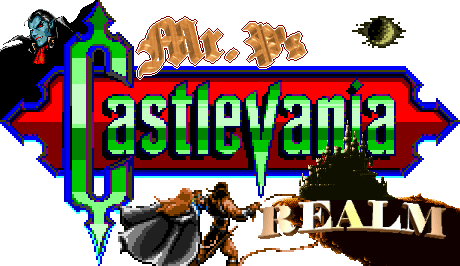
![]() Other Recurrences
Other Recurrences ![]()
|
Super Castlevania IV
|
Castlevania: Symphony
of the Night
|
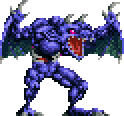  |
  |
|
When Slogra is damaged enough, he'll shed the spear and begin using his crouching beak dash. (Gaibon, if you let him live to this point, will continue to carry Slogra up to safety after each sword or whip strike.) When Gaibon is damaged enough, he'll turn red, wherein he becomes faster and his fireballs become more rapid. After defeating this vile team, you can move on. You'll run into both later--well, many individual incarnations of both, in fact--in the reverse castle; by this time, no Slogras or Gaibons should be a match for you. |
|
"Dracula X"
Games
|
Castlevania: Symphony
of the Night
|
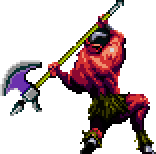 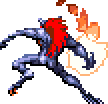 |
  |
Lypuston and Minotarusu, as they're better known on this site, return from the Dracula X games as a team and as the chief servants of the spell-induced Richter Belmont. As with Slogra and Gaibon, both retain most of their powers from their past formations--but they add team elements in there as well. The Werewolf (described as a shape-shifting lycanthrope) can reach back, generate a blue flame, and throw it forward; he'll also cling onto the ceiling and dart toward you, sometimes hitting the floor with his fist and sending flaming debris everywhere. Minotaurus will readily attempt to poke you his ax or breathe stone-inducing mist in your face; he'll also use the ax for a diving ax thrust. When he's had enough of that, he'll flip the ax into the air and strike you with a flaming uppercut, getting back in time to catch his weapon.
 As
for teamwork: The move that they have in common is the air-dash, and they'll
use this to crisscross each other frequently. When the two get close together,
the Werewolf will curl into a ball, then Minotaurus will grab onto him
and bounce him around like a basketball--which will be reminiscent of
Lypuston's rebounding attack in the Dracula X games; the Werewolf
can alternate the move by rolling around the walls and ceilings. On the
sports note, they'll also play a game of baseball: When Lypuston throws
the blue flames, Minotaurus will sometimes redirect them by swinging forward
with his ax. It's always best to concentrate on eliminating one of them
quickly in order to make it a one-on-one battle. The Werewolf is tougher
as a singles foe, incidentally, so you'll want to defeat him first. As
for teamwork: The move that they have in common is the air-dash, and they'll
use this to crisscross each other frequently. When the two get close together,
the Werewolf will curl into a ball, then Minotaurus will grab onto him
and bounce him around like a basketball--which will be reminiscent of
Lypuston's rebounding attack in the Dracula X games; the Werewolf
can alternate the move by rolling around the walls and ceilings. On the
sports note, they'll also play a game of baseball: When Lypuston throws
the blue flames, Minotaurus will sometimes redirect them by swinging forward
with his ax. It's always best to concentrate on eliminating one of them
quickly in order to make it a one-on-one battle. The Werewolf is tougher
as a singles foe, incidentally, so you'll want to defeat him first. |
|
Dracula X: Rondo of Blood
|
Castlevania: Symphony
of the Night
|
 |
 |
Shaft first appears in the Rondo of Blood, where he's a more active participant. At part of his gameplan, though, he will initially conjure up some servants and then step to the sidelines as the heroes tangle with, in order, the Mummy, Medusa, a Phantom Bat and the Frankenstein Monster. After the defeat of the four servants, there's no time to rest or regain energy because Shaft will teleport in for a final showdown. As Shaft teleports about, avoiding actual combat, he'll command two magical orbs to adopt elemental properties and attack in obvious patterns: (1) They'll transform into two large stalking flames that can be redirected if struck. (2) They'll float atop the screen and blast down parallel bolts of lightning. (3) They'll magnetically rotate around an invisible center point, thereby creating a a rather large obstacle.
Shaft returns in Symphony of the Night for what is a similar battle. Because he's this time without the aid of other ultimate evils, he ups his game by magically creating a virtual storm of elemental orbs. Before they spring to life, Shaft will place himself within the confines of a forcefield protected by rotating rings; this device allows him to move about the room as he pleases as the orbs do all of the work. That is, any number of electrically charged orbs will continue to rebound around the room to overwhelm the hero. At any time, a random pair of orbs can jump to opposite sides of the room, where they'll line up parallel, and create between them a damaging energy bolt; they'll then for a short period move the bolt vertically, up and back down, at room's length. With so much going on, it's difficult to concentrate on Shaft, the target in question.
|
Castlevania III: Dracula's
Curse
|
Castlevania: Harmony of
Dissonance
|
 |
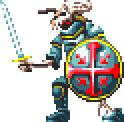 |
In his special interview in Castlevania Chronicles, one of the game's creators, who was also one of the staffers that produced Symphony of the Night, noted his love for Castlevania III: Dracula's Curse. In tribute to that, he brought back a couple of its boss creatures. Back then, the Skull Knight, a lesser version of the Skull Knight King, could only patrol back and forth and throw a short-ranged sword slash. Hundreds of years later, the Skull Knight has learned some new tricks.
 The
Harmony version has to be defeated three times: It will
initially fight like it did back then: It'll charge toward you with high
jumps and swing its sword mightily. If you strike the Skull Knight, it'll
put up its shield and thwart any of your attacks. After you strike the
Knight enough times, it'll lose its sword and submerge into the ground,
signaling the start of round two. Without its sword, it'll now rely on
its devastating dash attack, which can be executed the length of the room,
depending on your position. This attack will be used often, forcing you
to stay mostly airborne. When struck some more, it'll finally lose all
of its protection and once again submerge into the ground, popping back
up elsewhere for the final round. This time around, the Skull Knight debuts
its most powerful attack: An expanding laser which can only be ducked
under; its duration is usually lengthy, but the Skull Knight will sometimes
intentionally flash it shortly to psyche you out. The
Harmony version has to be defeated three times: It will
initially fight like it did back then: It'll charge toward you with high
jumps and swing its sword mightily. If you strike the Skull Knight, it'll
put up its shield and thwart any of your attacks. After you strike the
Knight enough times, it'll lose its sword and submerge into the ground,
signaling the start of round two. Without its sword, it'll now rely on
its devastating dash attack, which can be executed the length of the room,
depending on your position. This attack will be used often, forcing you
to stay mostly airborne. When struck some more, it'll finally lose all
of its protection and once again submerge into the ground, popping back
up elsewhere for the final round. This time around, the Skull Knight debuts
its most powerful attack: An expanding laser which can only be ducked
under; its duration is usually lengthy, but the Skull Knight will sometimes
intentionally flash it shortly to psyche you out. |
|
Castlevania III: Dracula's
Curse
|
Castlevania: Harmony of
Dissonance
|
 |
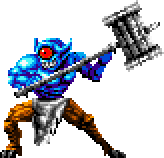 |
Much like the Skull Knight, the Cyclops was another favorite of Harmony's staffers. So after a long layoff, it returns to the team. It makes you wonder where most of these bosses go when they're absent from a game. Does Dracula send them to a minor league division for evil? Anyway: The Cyclops as you knew it was limited offensively because of its bulk. With its sledgehammer in hand, it would slowly march toward you and try to plant it into your skull. If you were to stay grounded, it would occasionally show some speed and execute a dash in your direction, gaining better momentum for its hammer smash. The Cyclops returns over three hundred years later, bulked up, trickier, and with a much higher rank--it's ultimately the game's second-last regular boss.
The Cyclops in Harmony is like a cross between the Minotaur and Skull Knight from the same game. Its nimble in its movement, both while on the ground and in the air, and it executes its hammer smash with excellent speed, wide range, and a crippling amount of power. At any time, it will also execute its new and improved dash attack, very much mimicking the Skull Knight--using this move, the Cyclops can reach as far as the room stretches, again depending on your position; however, the Cyclops' dash is quicker than the Skull Knight's and comes with less warning. These turn out to be its only two moves, but at that point, where it's late in the game, that's about all it needs. Your only real advantage, as you've had over similar enemies, is that you can force the Cyclops to retreat slightly by striking it repeatedly.
|
Castlevania: Aria of Sorrow
|
Dawn of Sorrow / Portrait
of Ruin
|
 |
 |
Balore appears in the two Sorrow-themed titles and Dawn's DS follow-up, Portrait of Ruin. In Aria of Sorrow, it will at first seem as though another pesky phantom bat will stand in your way. Balore will end that threat by crushing it to death, an act of intimidation from one of the more powerful bosses. Though, only the gigantic Balore's face and fists will be visible to you. The objective is to damage its open right eye while avoiding contact with its fists, which are always in motion; it's especially a bad idea to remain underneath the open eye because Balore is always crashing its fists into the ground where you stand, contact that always knocks you across the room. When the right eye is damaged enough, it'll retract its fists and open the left eye. This eye will expel across the ground, from left to right or vice versa, lasers that make a wave of flame ignite in that direction; the pace of this attack quickens as you damage the eye further. In this case, you'll have to execute quick jumps to clear the high-rising flames and find a way to initiate own offense.
Balore returns in Dawn of Sorrow (and then again in Portrait of Ruin, ripped by the developers directly from the previous Dawn of Sorrow) to again intimidate. The more compressed and yet still fearsome Balore will this time use a single arm, which it will always keep in motion. Using its overmuscled limb, Balore will strike in two ways: Either by crashing its fast into the ground, in an attempt to smash grounded prey, or by throwing toward the ceiling a vicious uppercut should the hero be at the time airborne. Though, they don't for nothing describe Balore as "having a fear-inducing gaze," which is more terrifying when you actually see it. That is, Balore will at any point fire from its exposed eye a devastating expanding laser, which can strike multiple times for a possible one-shot kill.
|
Castlevania: Legacy of
Darkness
|
Castlevania: The Arcade
|
 |
|
This half woman, half bird remains mostly airborne, flying all around, back and forth, above the castle's outer wall and through the unforgiving sky--so much so that it'll throw off any typical attack you can muster. From the air, it will either try to blast you by darting its sharp-pointed feathers in threes, or it'll try to swoop down and catch you in its claws, which will damage you greatly before the release. As a final attempt to finish you off quickly, it'll land and flap its wings wildly, which'll cause fierce winds that can push you off the edge of the small battle area if you don't resist. But the battle remains mostly in the air--you'll spend most of your time chasing the Harpy around, trying to get your lock-on feature to find its mark, so that you can strike at a distance. If you're strong enough, and you get lucky when trying to lock on to it, the battle shouldn't be all that difficult or last all that long.
The arcade version employs a similar battle plan: This Harpy will remain mostly airborne, hovering defensively and dodging attacks as it looks for an opening; when the hero is properly targeted, the Harpy will either spew a blue-flame projectile or dive in with a swoop-attack; too, it can execute a more upfront charge with its talons extended. The Harpy will use its speed to quickly fly behind the hero and from the blind-side unleash a striking attack, which can be thwarted if the hero acts with enough haste. Should the Harpy touch ground, it'll gather energy and unleash a series of mini-tornados, which can both damage heroes and push them back, perhaps to a plunging death. At about half-life, the Harpy will begin utilizing a pounce attack, as if repeatedly stabbing itself into the ground. In its last, desperate moments, the Harpy will attempt to get in close, grab the hero, and physically drag him/her off the tower's stop, scoring a cheap victory.
|
Castlevania: Order of
Ecclesia
|
Castlevania: Grimoire
of Souls
|
 |
|
Order of Ecclesia's Eligor is, of course, is absurdly large demon that was summoned to protect the castle. The systematic battle commences after you're sent crashing into the room's right wall while attempting to mount the seemingly inanimate Eligor. Your goal here is to work your your way beneath Eligor, then over to its left side, and finally onto its back--the point from which you can get a clear shot at its vulnerable point: its oddly placed eye. Only after you break its red-crystal kneecaps (which will eventually regenerate) will it stand on its hind legs, in great pain, and leave you the opportunity to run beneath it; as you attempt this, Eligor runs interference by alternating between sword attacks (a downward stab or a swipe-and-drag motion, depending upon the hero's position) and hunching down to fire arrows from an installed crossbow, which can be destroyed. While beneath Eligor, you'll have to safely reposition yourself and avoid direct contact and its front-leg kicks. Soon Eligor will execute a jump attack and leave you enough time to advance to its left side; from there, you have to destroy another set of knee crystals and do so as Eligor attempts to disrupt the effort with back kicks, tail-stabs, and arrows as fired from its second, more-rapidly-firing crossbow. When these kneecaps are destroyed, Eligor will slump to the ground, and its idle tail will become climbable and give you direct access to both its back and the main target. Though, Eligor will eventually recover, and it'll attempt to limit the onslaught with one of its most damaging attacks: a tail whip; a curled-tail stab; or when it's really low on health, a leaning headbutt. Any of these can potentially knock the hero back down to the room's right side and unfortunately restart of the cycle.
The Grimoire of Souls version of Eligor (aptly nicknamed "The Duke of Hell) is highly faithful to its Order of Ecclesia counterpart, and thus the battle against it entails a similar level of complexity. What makes this battle worse, though, is that it's now a two-phase affair. To complete the first phase, you have to gain access to and strike the eye that's positioned on the back of Eligor's head. Though, getting within range of it takes some extra effort. Fortunately, Grimoire's heroes are much more mobile than their canon-series counterparts, so they're able to use their advanced jumping ability to avoid the process of destroying Eligor's front-knee crystals, passing beneath it when it reacts with pained rearing, and then destroying its back-knee crystals. It's advantageous to target and destroy the crystals, though, because doing so causes Eligor to enter into a stunned state during which you can freely pound on him. Eligor, as expected, has all of the same attacks: the downward-aimed sword-stab; the swipe-and-drag sword attack; the ground-pounding jump; the leg kicks; the tail-stabs; and the arrows as fired from two installed crossbows, both of which can be permanently destroyed. And it adds two more: an enflamed rearing stomp, which it executes when it's facing you, and a backward, overhead sword stab, which it executes when you're on its back. When you take out the eyeball, the second phase begins. At this point, Eligor's torso turns, and its helmet opens up to reveal and angelic face--your new target. While in this form, Eligor ditches the sword and instead defends itself by throwing haymaker punches; if such a punch connects, you'll be knocked; also, its installed crossbows now fire two arrows at a time.
|
[Home] [What's New?] [CV Library] [Stages] [Reviews] [Weapons] [Castleography] [Multimedia] [Codes] [Links] |
||||
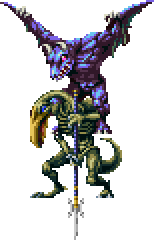 One
of the surprises of Castlevania: Symphony of the Night comes
early on when you run into Slogra and Gaibon, two of the boss guardians
you faced a long time ago on the last level of Super Castlevania
IV. Better yet--both look, act and attack identically to their past
formations. The only difference, this time, is that they have some tag-team
moves that they can use at any time. When you enter into their chamber,
both will begin firing at you with their respective powers: Slogra will
shoot explosive blasts from the tip of his spear while Gaibon will spit
fireballs while grounded or while flying through the air--diagonally
downward while in the air. If you strike Slogra, Gaibon will lift him
into the air; Gaibon will then fly back and forth with him in tow until
Slogra points the spear downward and is ready to land on your head.
One
of the surprises of Castlevania: Symphony of the Night comes
early on when you run into Slogra and Gaibon, two of the boss guardians
you faced a long time ago on the last level of Super Castlevania
IV. Better yet--both look, act and attack identically to their past
formations. The only difference, this time, is that they have some tag-team
moves that they can use at any time. When you enter into their chamber,
both will begin firing at you with their respective powers: Slogra will
shoot explosive blasts from the tip of his spear while Gaibon will spit
fireballs while grounded or while flying through the air--diagonally
downward while in the air. If you strike Slogra, Gaibon will lift him
into the air; Gaibon will then fly back and forth with him in tow until
Slogra points the spear downward and is ready to land on your head.